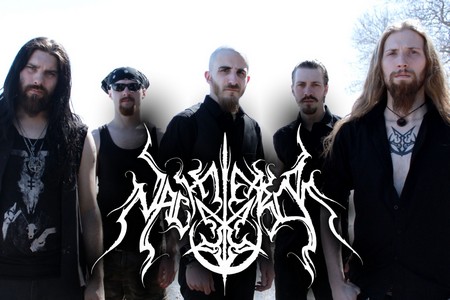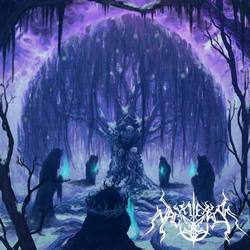Splits are often fascinating listens. Being able to combine two bands onto one release gives the listener a bit of variety and gets a band’s name out to fans of another. The best splits take two (or more) similar bands in a genre and mash them together – allowing their differences to come forward. One of the most interesting splits of the year to date is that of Nachtterror and Altars of Grief’s recent output, Of Ash and Dying Light. Originally released in July, a vinyl edition is now available as well through Hypnotic Dirge Records. Thorough is the best word to describe the split – going so far as to give each band their own incredible cover art (see the bottom of each interview page) to adorn each side, as well as providing digital bonus tracks to really flesh out what each band’s statement of intent is.
We were able to reach out to both bands to provide some added depth to this release. Being that there were a number of similar questions, it seemed that putting together a split interview would be in intriguing idea. So below are the answers from Erik Labossiere of Nachtterror, and page two provides the answers from Altars of Grief’s Damien Smith. Read on to discover information about the artwork of both albums, what they are up to currently besides the split, and more.
Nachtterror
Dead Rhetoric: How would you describe the band for someone who has not heard Nachtterror before?
Erik Labossiere: I would say Nachtterror is best described as Melodic Blackened Doom centered on symphonic elements and emotional dynamic. Nachtterror has a heavy focus on conveying a story through the music and lyric, so the music utilizes a full spectrum of emotion. Depression, aggression, nihilism and fear are all elements used in the creation of Nachtterror’s sound.
Dead Rhetoric: Who are some of the bands biggest influences?
Labossiere: Without question the early years of Nachtterror were influenced by bands like My Dying Bride and Cradle of Filth. Being a band that was established in 2004, the visual and stylistic intensity these bands performed with was very engaging to us, and as time went on we’d find influence in more bands of the same world such as November’s Doom, Virgin Black and in more recent years Woods of Ypres and Agalloch. Outside of metal, we take heavy conceptual influence from Akira Yamoaka, the lead music writer for the Silent Hill franchise. Both the story telling and mood created in these games play a major role in our writing style.
Dead Rhetoric: You’ve completed two EP’s and a split. Is the process different compared to that of your upcoming full-length, Judgement?
Labossiere: Recording Judgement has been our largest, most invested project to date. Unlike the previous releases that were self-recorded, this album was recorded in studio with an absolutely awesome sound engineer, Justin Bender. We wanted to do quality justice to a story and concept we feel very proud of. It’s also worth noting that while the other releases were recorded in a matter of days, Judgement is a slow burn process, recording, analyzing, touching up. We want to make sure this release is “perfect” by our standards as it will be the defining release of Nachtterror up to this point.
Dead Rhetoric: Judgement has been 10 years in the making. How much fine tuning have you done to it over the years?
Labossiere: That’s an interesting question. Nachtterror began creating the concept for Judgement in 2006, and wrote about half of the album before getting stuck musically. For whatever reason we couldn’t find the songs to fill in the areas of story necessary. We let Judgement sit for a little while as the band went through various lineup changes, hiatuses and focus shifts. In a way, we weren’t ready to write the rest of Judgement because we had not grown enough as people to fully understand the emotional states we were trying to create. We had to evolve as people so we could properly understand the emotion behind the story. It’s really interesting reflecting on the songs themselves and how much of our own lives and struggles can be read within the album. Its like a big analogy to our collective pain and growth.
Dead Rhetoric: Will you be putting up any more behind the scenes Youtube videos?
Labossiere: Oh absolutely we will! We’ve taken a massive amount of footage from in studio and on the road for the purpose of creating a documentary bonus dvd to be released with the Judgement album. I really enjoyed creating that “Vocal BTS” video and giving some simplified insight into Nachtterror’s focus on storytelling. I’ll definitely be producing more of these as well, the next release to focus on the artwork of Judgement as painted and created by our lead guitarist Maelkleth.
Dead Rhetoric: Viewing the behind the scenes vocal video, it seems Nachtterror puts a lot of focus on storytelling. Are there any stories to be found on your split release?
Labossiere: Indeed there is! Both “Breath of the World Ablaze” and “Upon Ashen Shore” actually fit into the Judgement story concept. They were written as standalone tracks together – telling the story of a dark gods rise and wrath upon the world, but the tracks also fit lyrically into Judgement‘s character plotline. We wanted the tracks to be able to exist conceptually independent of Judgement, but also be a part of the whole lore of Vatiel (our dark god) and complete storyline.
Dead Rhetoric: There are some notable exceptions, but many bands don’t focus on storytelling. Why do you feel it is important?
Labossiere: I have the utmost appreciation for bands that write pure music. There is plenty of artistic merit in creating a great sounding song, but we as a whole are more interested in storytelling not only because we are fanatical fans of depth in media, (be it Asian horror movies, the lore found in video games or Shakespearean writings) but also because we love to create that experience and storytelling allows us to play with more dynamic and depth in writing. We chose to have our music mimic the emotional state of our protagonist in Judgement to test our abilities to relay emotion in music. The album isn’t written as “this is a sad song” or “this is an angry song” but more “what does this lyrical passage in this moment of his life and his emotional state sounds like.” This concept has lead us to not only be freer in creation but forced us to grow as musicians. Its hard to create something for a character you can’t feel yourself, so we had to learn where to draw from these emotions from within ourselves. Its been a very cathartic and engaging process.
Dead Rhetoric: Do you feel there’s more stress on releasing a full length than an EP/split/single?
Labossiere: I think there’s more opportunity in releasing a full length! I love creating music and I even moreso love promoting and creating media for it. Whether its a short promo video, a music video, a documentary piece or something as simple as a still image, I love to show the world our concept in different formats. An EP/split/single is definitely a simpler process in releasing but I find way more joy in getting inspired to create even more for an album be that in media or networking or touring. More stressful? Sure. One could say that. More rewarding? Absolutely.
Dead Rhetoric: Could you explain your side of the album art for Of Ash and Dying Light?
Labossiere: It was created by Sam Nelson to match the style he did on the Altars of Grief side. After seeing his work on their full length album and their side of the vinyl, we definitely wanted to work with him. The concept of our art revolves around the “Kings of the Otherside” that are basically a hyperbole version of our band members. Like the witches in Macbeth, we guide and tell the story of Vatiel and Judgement and this image represents us meeting around a “tree of death” of sorts (a fitting duality for our story) in a forest clearing. Actually, the perspective of our side is supposed to be the reverse angle of the Altars side, as in, if you were to flip the camera behind her, you would see our tree in the distance.
Dead Rhetoric: You’ll be our on tour this summer with Altars of Grief. If you could tour with any bands, who would you choose?
Labossiere: Well, as I write this mere days after tour, I can tell you that we absolutely loved touring with Altars of Grief. They have a very similar feel and focus in both writing and sound, and also have a similar focus in live performance. It felt like we meshed very well. We also got the share the stage with Numenorean from Calgary, Alberta who were another great fit for the tour. Three bands with diverse sound but a heavy focus on creating tragic emotion through music. It was fantastic. We also hope to share the road with other Canadian acts like Psychotic Gardening from Winnipeg, Manitoba. We’ve known them a number of years and definitely drew influence from them in our earlier years.
Dead Rhetoric: Whats next for Nachtterrror?
Labossiere: We plan on putting the final touches on Judgement and deciding on a release date for that! We have a couple Music Videos in the works, more behind the scenes videos as well are planning on a Spring/Summer tour across Canada. After 10 years of planning for this release, we plan to pull no expense and push this release as hard as we possibly can in the hope that as many people as possible will enjoy and find this story and album as fulfilling as we’ve found creating it.



